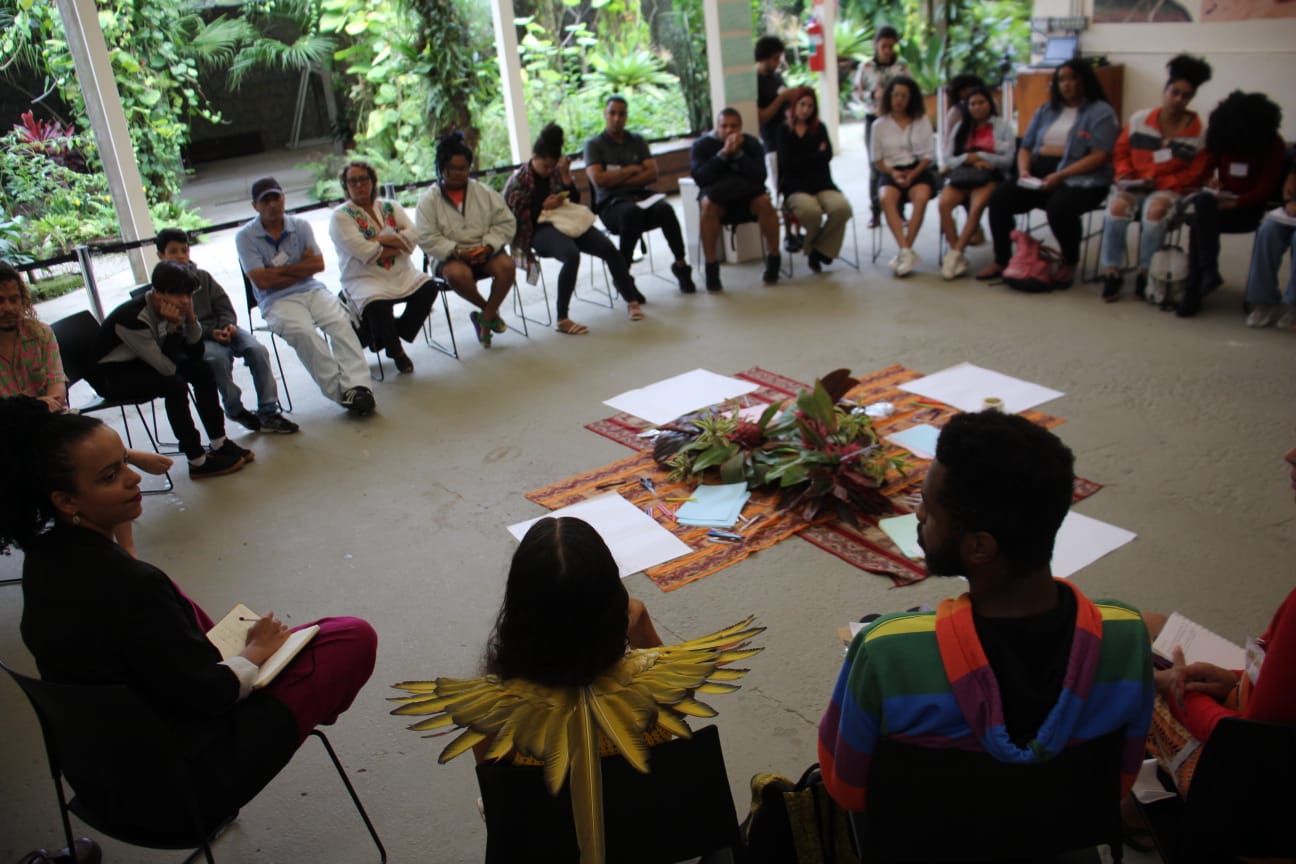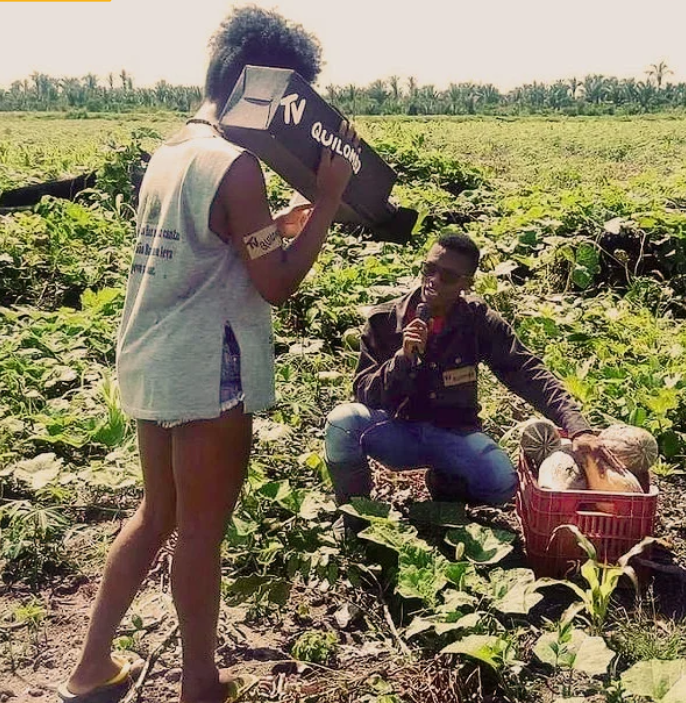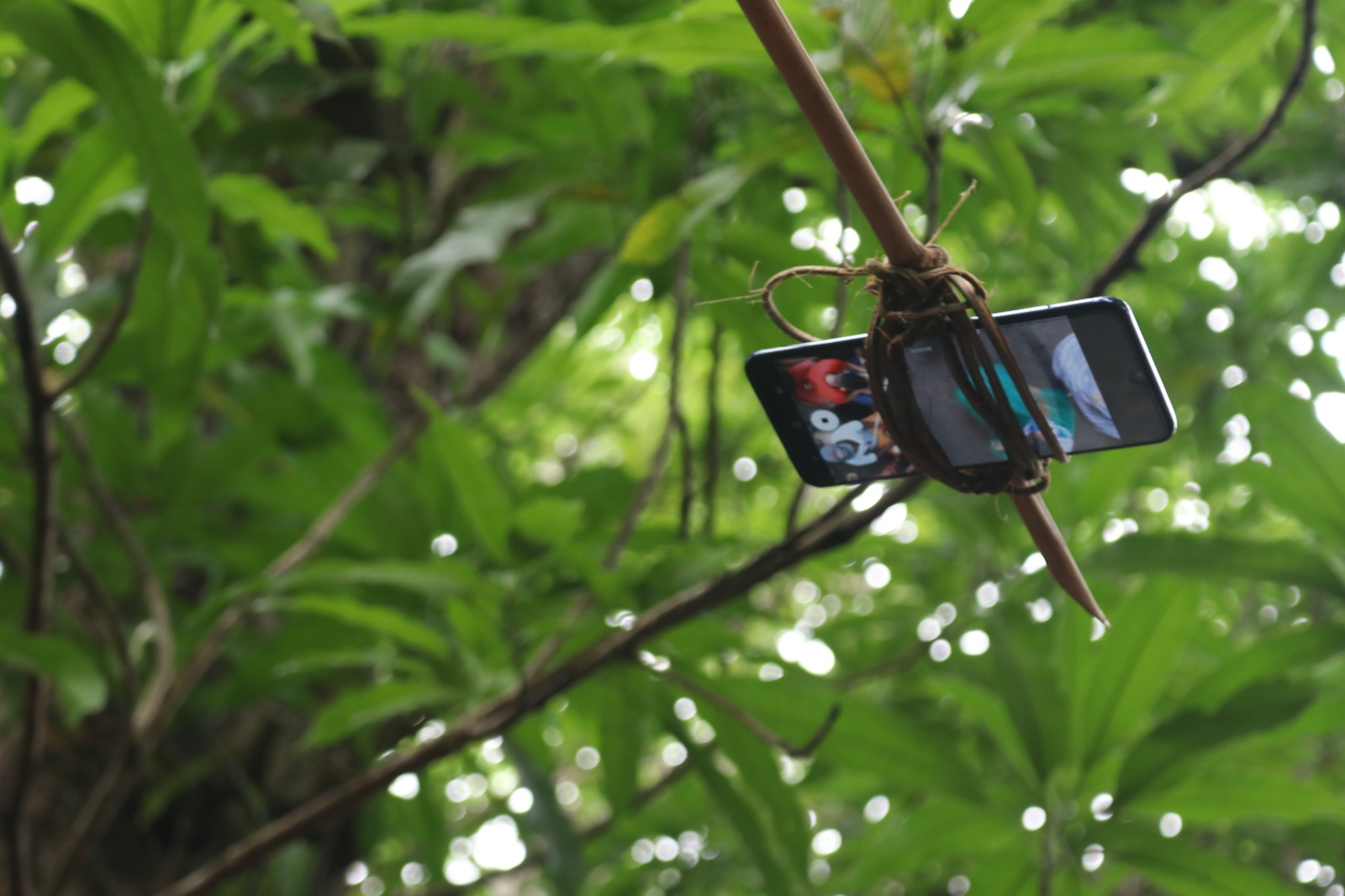
The Peripheral, Favela, Quilombola, and Indigenous Media Coalition brings together a network of journalism initiatives as ancestral technology to end the silences in the media market and change the future of journalism in Brazil with Black, favela, indigenous, peripheral, and quilombola voices, chanting “from within to within,” highlighting location, race, ethnicity, gender, and class.
“We are the Peripheral, Favela, Quilombola, and Indigenous Media Coalition. A set of journalistic and ancestral technological solutions to produce and share information of public interest in social contexts in which Internet access is precarious or non-existent… We work towards a media that is anti-sexist, anti-racist, anti-ableist, anti-LGBTQIA+phobia, and anti-ageist.” — Coalition launch manifesto, May 2023
The initiative is concerned with knowledge-producing technologies in service of the collective work of peoples, territories, and ancestral wisdom in favelas, urban peripheries, villages, and quilombos. The Coalition has been developed by 11 organizations: Periphery in Movement (SP), Desenrola e Não Me Enrola (SP), Third Street Margin (SP), Maré Mobilization Front (RJ), Fala Roça (RJ), Turmoil Network (PE), Mojubá Media and Connections (BA), TV Comunidades (MA), Quilombo TV (MA), Tapajônico Youth Collective (PA), and the Media Collective for the National Coordination for the Articulation of Rural Black Quilombo Communities (CONAQ). Officially launched during the Digital Journalism Association’s (Ajor) 3i Journalism Festival, the Coalition wants to reinvent journalism in Brazil, starting from the grassroots, rooted in what is happening on the ground.

Another way of explaining the initiative is through a Yoruba proverb: “Eshu throws a stone today and kills a bird of yesterday.” The proposal is not about visibility or having a voice but about building the future of journalism in Brazil.
To achieve this, the Media Coalition works in three primary ways: “Local and national advocacy, knowledge exchange of ancestral technologies for communication and journalism, and a consortium of content production.”
“We are not just community media doing journalism, we are also media that want national and regional political influence. We want to argue for and encourage public policy through the media we produce,” states Michel Silva, director of reporting at Fala Roça, a community media outlet in the Rocinha favela, in Rio de a Janeiro’s South Zone.
For Silva, community-based media face a “barrier” in the media culture instilled in the general population by the mainstream media. He believes that working to create a viable and sustainable ecosystem of peripheral, favela, indigenous, and quilombola media is essential to break down this social barrier.
“We have to break down [this barrier] because the majority of our communities have their critical thinking contaminated by the mainstream media. How can we argue with society, with the opinion of our own people about, for example, violence against Black youth, if we live with our own people saying ‘good CPF’ [Brazilian tax ID] or ‘cancelled CPF’ about people in the community? This thinking and way of seeing life didn’t come out of nowhere. It was built by lunchtime sensationalist TV news reports. So, we need to find ways to sustain ourselves, but we also need to share our content and make it visible. And for this we have to have content exchanges, an accumulation, a coalition platform.” — Michel Silva
For grassroots journalists, this is the principle of existence for community media: to value and respect ways of living in communities. Another common thread is the recognition of ancestral practices in communities as technology.
As such, the Media Coalition does not want to be just another tool to access communications rights, but a political platform for lives, bodies, and identities in areas that are historically neglected and silenced by traditional media. This is how the group chose the name Media Coalition, as activist Gizele Martins explains.
“In an indigenous village they maybe use a different communication concept. In Maré, we call ourselves community communication. Fala Roça, in Rocinha, self-defines as favela journalism. So we talk about ‘media’ [in the plural] and a Media Coalition so as to respect [territorial] differences.” — Gizele Martins
Martins is a community journalist from the favelas of Complexo da Maré, in Rio de Janeiro’s North Zone, human rights defender, and member of the Maré Mobilization Front which was founded in March 2020 to combat misinformation during the coronavirus pandemic.
“We spent a lot of time distributing baskets of basic foodstuffs because we went in to combat hunger. But the Front is a community media collective. For us, this is like a continuation of the work we did in the pandemic…
If you look at the organizations that are part of the Coalition, you’ll notice that they are media outlets that have worked in these territories fighting fake news and hunger. Beyond media, there are collectives that we also identify with as those that have worked during the pandemic. They are the ones doing community journalism and communication that takes a stance, that is ideological, anti-racist, and that aims to challenge the journalism agenda. Actually, not only the agenda, but also the concept of journalism within universities. We want to challenge what journalism is.” — Gizele Martins
Michel Silva says that the idea for a Media Coalition emerged in a meeting in 2022 in São Paulo. People who build community media in different parts of Brazil came together and realized they share the same concerns over how they can sustain their activities in the long term. So they decided to join forces.
“I was already thinking about how community media in Rio de Janeiro can become sustainable. How they can be seen by organizations as a whole, as a consortium of media outlets. I found out that the people in São Paulo also had the idea to build something like a network to value urban periphery media outlets working on communication in Brazil… There are people who are in the Coalition to discuss and consider ways of nurturing media, there are people who are more interested in the issue of creating media, others want to value reporting and networking relationships.
The Coalition is a mix of common interests. We come from and use community media, grassroots media, as a tool for political struggle. This is why, among the possible names, we chose the word ‘coalition’ as it has this political aspect. The aim is that we have a strong network in which we can build Brazilian [grassroots] media.” — Michel Silva

For Ronaldo Matos, co-founder and editor of Desenrola e Não Me Enrola, the Coalition initiative represents a “democratization movement” that is emerging to have a direct contribution on the future of journalism.
“This gap, this abyss of journalistic coverage we currently have in communities doesn’t just happen in São Paulo but across the whole country. This is the problem we are attempting to attack and overcome.” — Ronaldo Matos
Matos shares the example of technology developed by Desenrola e Não Me Enrola: “It was significant [in] developing a methodology for teaching journalism that nurtured the debate with youth, making them reflect on the political context of their neighborhood, the memory, and public policy that either doesn’t come or is denied.” The process also influences the reporting produced.
“When we started out, you didn’t really use the term peripheral journalism. There was community journalism, citizen, independent journalism, alternative media, but the term peripheral journalism didn’t exist.” — Ronaldo Matos
Ancestral Journalism

Located in the Vargem Grande municipality in the state of Maranhão, Quilombo Rampa produces technologies that are not just ancestral but based on the land, according to Quilombo Radio and TV founder Raimundo José.
Using a humble smartphone donated by his sister stuck inside a cardboard box made to resemble an old TV camera, José began recording and producing stories from the eldest community members.
“We don’t have money to buy anything. No camera, no cell phone, not even a tripod. So, out of necessity we created an alternative based on our reality, creating quilombola technology… It was a huge challenge because they had never seen a camera before; even though it was a cardboard camera, it was a structure they’d never had contact with before, it wasn’t part of our reality… for each need that emerged, we’d create an alternative. That’s how the cardboard camera and bamboo camera support, the tripod, came about.” — Raimundo José
Quilombola technology also developed a “bamboo-drone,” a 10 meter bamboo pole with a cell phone attached to the end. The “bamboo-drone” is used to capture aerial images of drum circles in the community.
“We took bamboo from the bush there and managed to use it to develop this TV movement, filming [from above], reporting stories and showing them to people.” — Raimundo José
For José, creativity comes from the community’s traditional wisdom and culture and not just out of necessity. The technologies are fruit of the observation, knowledge, power, and innovation presented by ancestry that is very much alive in the territories.
“We started creating our own materials to support our programming, to tell the reality of the community. We were born with this mission. Even though it’s difficult to access things, it also brings people closer because it makes real communication with the community happen.” — Raimundo José
According to José, taking part in the Media Coalition is an opportunity for visibility, but above all for building policies that democratize the means of communication.
“We live the reality of how these voices have huge difficulty reverberating. The content we put on Quilombo TV doesn’t manage to reach the whole of Brazil, even on social media.” — Raimundo José

With the Coalition, José believes that grassroots journalists can carry out exchanges of content, possibilities, methodologies, and ancestral technologies.
“As a coalition, we join forces. It is a necessary struggle because I often say that those of us who communicate from our land are fighting for life. It’s something bigger, it’s not just reporting. The struggle is to stay alive, to protect our communities, our cultures… That’s why we won’t give up until the silence is exhausted. We go together, with all these strengths, the power of peripheral, quilombola, indigenous, and favela media to shape a future.” — Raimundo José
About the author: Tatiana Lima is a journalist, popular communicator, and special reporter with RioOnWatch. She has a masters degree in Media and Everyday Life from the Fluminense Federal University (UFF) where she is currently studying for a PhD in Communication and is a member of Complexo do Alemão’s Researchers in Movement Study Group. A Black feminist born and raised in Favela do Quitungo and Morro do Tuiuti, Lima currently lives in Rio’s urban periphery.
